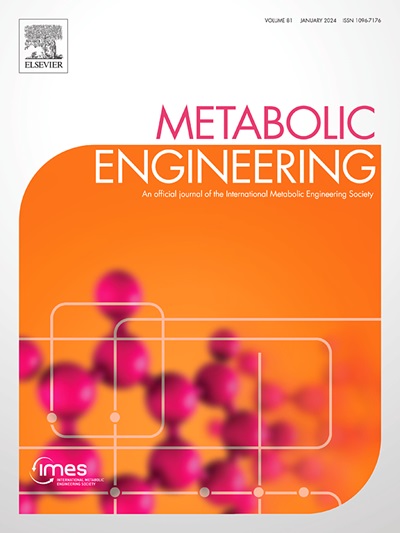Architecting a transcriptional repressor-based genetic inverter for tryptophan derived pathway regulation in Escherichia coli
IF 6.8
1区 生物学
Q1 BIOTECHNOLOGY & APPLIED MICROBIOLOGY
引用次数: 0
Abstract
Efficient microbial cell factories require intricate and precise metabolic regulations for optimized production, which can be significantly aided by implementing regulatory genetic circuits with versatile functions. However, constructing functionally diverse genetic circuits in host strains is challenging. Especially, functional diversification based on transcriptional repressors has been rarely explored due to the difficulty in inverting their repression properties. To address this, we proposed a design logic to create transcriptional repressor-based genetic inverters for functional enrichment. As proof of concept, a tryptophan-inducible genetic inverter was constructed by integrating two sets of transcriptional repressors, PtrpO1-TrpR1 and PtetO1-TetR. In this genetic inverter, the repression of TetR towards PtetO1 could be alleviated by the tryptophan-TrpR1 complex in the presence of tryptophan, leading to the activated output. Subsequently, we optimized the dynamic performance of the inverter and constructed tryptophan-triggered dynamic activation systems. Further coupling of the original repression function of PtrpO1-TrpR1 with inverter variants realized the tryptophan-triggered bifunctional regulation system. Finally, the dynamic regulation systems enabled tryptophan production monitoring. These systems also remarkably increased the titers of the tryptophan derivatives tryptamine and violacein by 2.0-fold and 7.4-fold, respectively. The successful design and application of the genetic inverter enhanced the applicability of transcriptional repressors.
在大肠杆菌中构建基于转录抑制因子的基因转换器,以调控色氨酸衍生途径。
高效的微生物细胞工厂需要复杂而精确的新陈代谢调控来优化生产,而实施具有多功能的调控基因回路可大大有助于实现这一目标。然而,在宿主菌株中构建功能多样化的基因回路具有挑战性。尤其是基于转录抑制因子的功能多样化,由于其抑制特性难以逆转,因此很少有人进行过探索。针对这一问题,我们提出了一种设计逻辑,以创建基于转录抑制因子的基因反转器,实现功能富集。作为概念验证,我们通过整合两组转录抑制因子(PtrpO1-TrpR1 和 PtetO1-TetR)构建了色氨酸诱导型基因反转器。在该基因反转器中,色氨酸-TrpR1复合物可在色氨酸存在的情况下缓解TetR对PtetO1的抑制,从而导致激活输出。随后,我们优化了反相器的动态性能,构建了色氨酸触发的动态激活系统。将 PtrpO1-TrpR1 的原始抑制功能与反相器变体进一步耦合,实现了色氨酸触发的双功能调控系统。最后,动态调节系统实现了色氨酸生产监控。这些系统还显著提高了色氨酸衍生物色胺和暴力素的滴度,分别提高了 2.0 倍和 7.4 倍。基因转换器的成功设计和应用提高了转录抑制剂的适用性。
本文章由计算机程序翻译,如有差异,请以英文原文为准。
求助全文
约1分钟内获得全文
求助全文
来源期刊

Metabolic engineering
工程技术-生物工程与应用微生物
CiteScore
15.60
自引率
6.00%
发文量
140
审稿时长
44 days
期刊介绍:
Metabolic Engineering (MBE) is a journal that focuses on publishing original research papers on the directed modulation of metabolic pathways for metabolite overproduction or the enhancement of cellular properties. It welcomes papers that describe the engineering of native pathways and the synthesis of heterologous pathways to convert microorganisms into microbial cell factories. The journal covers experimental, computational, and modeling approaches for understanding metabolic pathways and manipulating them through genetic, media, or environmental means. Effective exploration of metabolic pathways necessitates the use of molecular biology and biochemistry methods, as well as engineering techniques for modeling and data analysis. MBE serves as a platform for interdisciplinary research in fields such as biochemistry, molecular biology, applied microbiology, cellular physiology, cellular nutrition in health and disease, and biochemical engineering. The journal publishes various types of papers, including original research papers and review papers. It is indexed and abstracted in databases such as Scopus, Embase, EMBiology, Current Contents - Life Sciences and Clinical Medicine, Science Citation Index, PubMed/Medline, CAS and Biotechnology Citation Index.
 求助内容:
求助内容: 应助结果提醒方式:
应助结果提醒方式:


